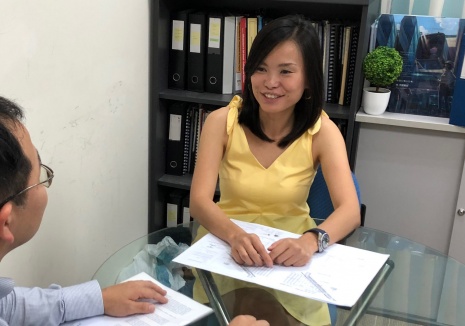Kiso-Jiban Staff Interview
Column

Ms. Michelle Lew is a director of Kiso-Jiban Singapore Pte. Ltd. and is active in the geotechnical engineering industry in Singapore.
Q. Why did you select a career in working for Kiso-Jiban?
A. Before joining Kiso-Jiban, I had worked 8 years in multi-disciplinary consultants. Being a geotechnical engineer in the design office, I had little opportunity to physically see and feel soil. Knowing Kiso-Jiban is the only firm who provide the full range of geotechnical services, from site investigation, field test, laboratory test, instrumentation to design, I joined Kiso-Jian in 2009. I believe that working in Kiso-Jiban help me in my career advancement in terms of gaining technical knowledge as a true geotechnical engineer. Indeed, my working and training experience in Kiso-Jiban has helped me in being certified as a Specialist Professional Engineer in Geotechnical Engineering in 2012. I am very grateful to Kiso-Jiban for my achievement.
Q. What is the job you are handling or handled?
A. I handle mainly deep excavations, deep foundation and reclamation projects ranging from infrastructures to residential and commercial buildings.
Q. Please describe your job more in detail.
A. My job involves managing projects, solving technical problems and carrying out complex FEM analysis. Managing a project can be very challenges especially when it comes to meeting the expectations of various parties (authority and clients). We have to ensure our design is safe & robust and at the same time, cost & time effective. My passion in geotechnical engineering drives me to take up challenging projects and be personally involved in solving technical problem and carrying out complex FEM analysis.
Q. What are you putting a great effort into?
A. In geotechnical engineering, nothing is constant. The soil condition and site constraints in every projects are different. In the beginning of each project, I will put great effort in studying the ground and water condition, the impact on nearby structures and both the design and construction risk. Our projects lately have been very complex and requires multiple unique engineering solutions. I have carried out several advanced 3D FEM analysis to provide comprehensive ground deformation prediction. Advanced FEM analysis is an important tool to understand complex engineering problems in construction.
Q. What is the tough job you have tackled before?
A. The toughest job that I have tackled is for the design and construction of a pedestrian linkway and two MRT tunnels for Marina Bay 3rd interchange Station along Thomson-East Coast Line . Our client is Taisei Corporation. The linkway was constructed underneath two existing live tunnels which are the Circle Line and North-South Line. Moreover, 28 numbers of existing piles supporting the North-South Line were cut progressively prior to underpinning works. We have successfully completed the works with very little impact on the existing structure. This was made possible by the close collaboration with Taisei’s engineers at every design and construction stages. We are currently embarking on the next challenge which is to conduct ground freezing prior to the two MRT tunnels construction.
Q. How is your workplace?
A. Kiso-Jiban workplace culture is one where everyone is encouraged to share our technical knowledge with anyone. We are never afraid to accept challenging project as we have many experts and experienced engineers who work together to come up with solutions. Everyone here works towards a common goal which is to serve our client to our best engineering capability.
Q. Where do you see yourself in five years?
A. In the next 5 years, Singapore will be constructing numerous deep underground infrastructure projects which include North-South Corridor Underground Road Tunnel, High Speed Rail, Cross Island MRT (56 stations), Changi Airport Terminal 5, Tuas Water Reclamation Plant, etc. It is my interest to do geotechnical engineering works. I see myself actively involving in many of these very challenging project as we are building in a denser environment with more interfaces with existing structures.
